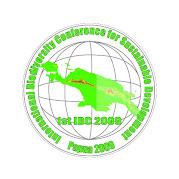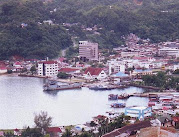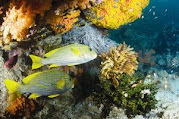Ecology, Biogeography, and Environment of Papua
By Bruce M. Beehler, Conservation International
Abstract
Papua supports the largest tract of equatorial forest wilderness remaining in Asia. Mountains define Papuan geography. The highest (snow-capped) peak of Papua is Puncak Jayakusuma or Puncak Jaya (4,884 m). Papua is estimated to house more than 15,000 species of vascular plants. Birds dominate the Papuan vertebrate fauna, with more than 600 species recorded. This includes more than 25 species of birds of paradise, three species of cassowaries, and some two dozen each of parrots, pigeons, raptors, and kingfishers.
The mammals are less in evidence, but include fruit-bats, insectivorous bats, tree kangaroos, possums, and rats among the 180 or so mammalian species. Amphibians include more than 130 species of frogs, many still undescribed to science. Reptiles include two crocodiles, 83 snakes, and 141 lizards. The fishes comprise ca 400 freshwater species and more than 2,250 marine taxa (about 1,500 of which inhabit coral reef ecosystems. There are probably in excess of 100,000 species of insects alone in Papua, only a fraction of these having been catalogued. As with Papua New Guinea, Papua is home to many traditional cultures—250 by one estimate. Many of Papua’s language groups are small and insular, with fewer than 1,000 speakers.
Papua is a land in flux. Significant chronic disturbance is produced by periodic vulcanism, human-caused and naturally-occurring fire regimes, plus El Niño drought.
Tanah Papua is immensely valuable to the global environment because it supports large expanses of unbroken natural forest and large intact marine ecosystems. Papua should thus be developed with care and planning. The earth benefits from the existence of Papua’s vast old growth forests—these produce abundant clean water for drinking; rich soils for subsistence gardens; timber and fiber for subsistence economies; and large natural ecosystems that stabilize regional weather systems and mitigate climate change. We should not lose sight of the importance of ecosystem services in tropical forest ecosystems. These supply much of the earth’s fresh water, which is growing scarce. Moreover, wild nature becomes increasingly valuable to an ever-more crowded and urbanized world. The rich developed countries and the large industries should be investing in these natural assets in the same way we want them to invest in carbon sequestration and REDD.
A rational and sustainable development regime for Papua will focus development nearest to the markets (on the coasts), and where infrastructure already exists (coastal urban centers). Road networks should be concentrated where the infrastructure lies already. Spending public funds to open up interior wilderness areas is not economically sound. A “smart” plan for developing Papua would keep the interior wild lands in large blocks rather than dissecting and degrading them. It would ensure the survival of Papua’s wildlife riches and ecosystem services, which are important to the traditional forest peoples of Papua. And it would balance intensive development in the urban areas against conservation in the wild lands in the interior. After all, Papua’s wilderness and its indigenous forest peoples make Papua unique. Keeping Papua unique culturally and environmentally will prove a winner in decades to come.


























